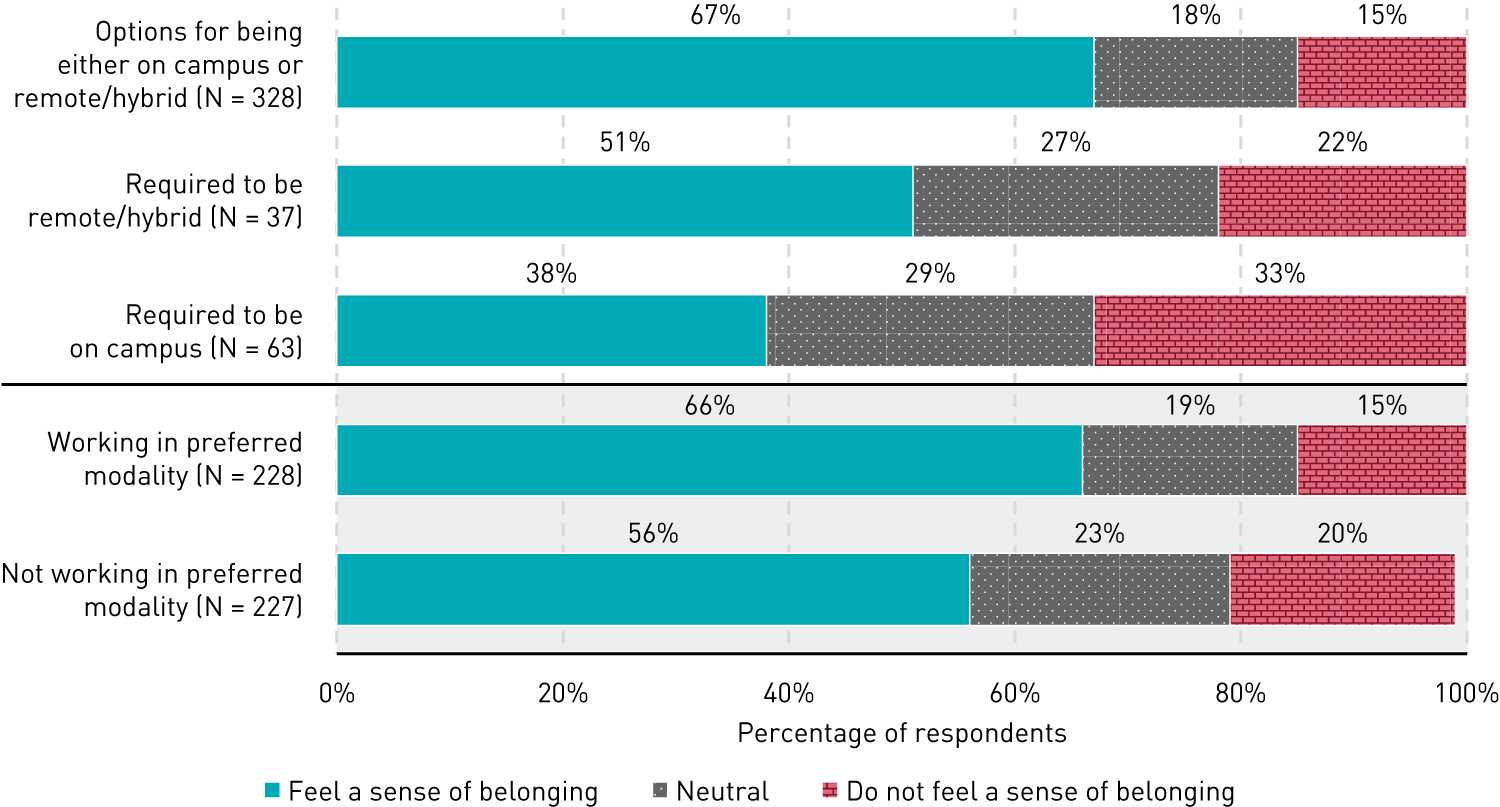A sense of belonging is essential for a positive and productive workforce, and it can be eroded by experiences of discrimination, inflexible work environments, and unsupportive leadership.

EDUCAUSE is helping institutional leaders, IT professionals, and other staff address their pressing challenges by sharing existing data and gathering new data from the higher education community. This report is based on an EDUCAUSE QuickPoll. QuickPolls enable us to rapidly gather, analyze, and share input from our community about specific emerging topics.Footnote1
For this EDUCAUSE QuickPoll, we partnered with the EDUCAUSE DEI Advisory Committee as subject-matter experts. We are grateful for their time and expertise informing this research.
The Challenge
Higher education leaders continue to grapple with the future of the higher education workforce. Employees' preferences related to work–life balance, work modality, and workplace policies are shifting, driving employers to respond quickly. Employers that do not respond adequately or swiftly enough find themselves dealing with increased turnover and staff shortages. Recently, CUPA-HR reported that having a sense of belonging is one of the top three predictors of employee retention.Footnote2 Here, we report on higher education employees' definitions of and sentiments related to a sense of belonging at work, along with concrete recommendations for actions leaders can take.
The Bottom Line
QuickPoll respondents who felt a higher sense of belonging were more likely to be satisfied in their current job roles, underscoring the importance of this issue for workforce retention. Respondents described "belonging" in the workplace as a feeling that their work is valued and appreciated, that they are part of a team and community, that they share mutual respect and support with colleagues, that everyone is included in work and social activities, that colleagues are accepting and welcoming, and that everyone is working with a shared mission. Higher education leaders can support their teams' sense of belonging by designing flexible, inclusive, and purposeful workflows; helping colleagues feel valued and appreciated; and focusing on meaningful one-on-one interactions. Further, with an increasingly remote and hybrid higher education workforce, specific attention should be paid to monitoring and supporting remote and hybrid workers' sense of belonging.
The Data: What Belonging Is and Why It Matters
Belonging is strongly associated with job satisfaction. Just over half (61%) of respondents indicated that they feel a sense of belonging at work (see figure 1).

A majority (90%) of respondents who feel a sense of belonging at work also reported that they are satisfied or very satisfied with their current position (see figure 2), as compared with just 8% of respondents who do not feel a sense of belonging at work. These data indicate that leaders hoping to retain their workforce may find supporting a sense of belonging to be a high-impact retention practice.

Outlying data suggest that not all members of the higher education workforce feel that a sense of belonging is a relevant issue. For example, one respondent submitted, "I don't think belonging is the goal or should be. There should be more of a meritocratic approach to decision-making in higher ed…. Do I need to belong to achieve my work or personal goals? No."
"Belonging" in the workplace has personal meanings. In open-ended data, respondents described workplace belonging as "a tapestry of commitment, successful interactions, pride, community appreciation, and recognition, woven together to create a sense of unity and purpose in the workplace." In an institution that fosters a sense of belonging:
Work is valued and appreciated.
"A personal feeling that your work is valued, your opinions are valued and respected, and that there is community self-worth."
Everyone is part of a team.
"Feeling as if we are all on the same team and have similar goals, that we can trust each other, that we are all accepted and appreciated not in spite of our differences but BECAUSE of them."
Colleagues share mutual respect.
"Feeling like you can trust, respect, and depend on your colleagues."
Everyone is included in work activities—and social activities, too.
"People include you in both professional and social activities, and…look to include your expertise in relevant work-related activities."
Colleagues accept and welcome each other as whole people.
"Feeling comfortable and safe to be your authentic self and accepted for who you are by others in the workplace."
Individuals are connected to a community across the institution.
"Feeling that you are a member of the community, through continued engagement and transparency. There is trust in the workplace and continued engagement throughout the institution."
Colleagues support each other.
"Everyone is encouraging of each other and supports their professional efforts. Lifting others up rather than competing with each other."
Everyone at the institution works with a shared mission, vision, and values.
"Feeling engaged, identifying with the institution and its values, feeling supported by leadership and team members, understanding our strategy, and looking forward to supporting the mission of the institution."
Closed-ended results align well with respondents' open-ended comments. Respondents who said they feel a sense of belonging at work also largely agreed or completely agreed with a list of statements based on both academic and popular understandings of workplace belonging (see table 1).
| Statement | Percentage of Respondents Who Agreed or Completely Agreed (N = 274–277) |
|---|---|
|
Welcomed as a Whole Person |
|
|
I am accepted at work. |
96% |
|
I can be myself at work. |
85% |
|
I can bring my whole identity to work. |
79% |
|
Valued and Appreciated |
|
|
My peers value my work. |
96% |
|
Leaders at my institution value my work. |
83% |
|
Part of a Team and Community |
|
|
I've developed authentic, human connections with my peers. |
96% |
|
I have at least one co-worker at my institution whom I would consider a friend. |
90% |
|
I've developed authentic, human connections with leadership at my institution. |
72% |
|
Working with Shared Mission, Vision, and Values |
|
|
The policies and practices at my workplace support diversity, equity, and inclusion. |
80% |
|
The policies and practices at my workplace support accessibility. |
78% |
|
My institution's social and political values are aligned with my own personal values. |
69% |
Not all individuals find value in considering the construct of "belonging" at work. One respondent explained that "the 'politics of belonging' has a negative association with attempts to define who is a legitimate part of a community or nation-state." Another respondent echoed this sentiment, saying "it feels too close to 'fit,' which I think of as a tool primarily for exclusion." This suggests that efforts to support employees' sense of belonging need to be appropriately framed for specific teams and institutions.
The Data: Work Experiences and Belonging
Leaders and newer employees feel a greater sense of belonging at work. Respondents in executive leadership roles have a greater sense of belonging (84%) than managers and directors (63%) or staff (56%) (see figure 3).Footnote3 Meanwhile, the longer respondents have been in their current roles, the less likely they were to report a sense of belonging: 46% of those who have been in their roles for more than five years indicated that they feel a sense of belonging at work, as compared to 54% of those who have been in their roles for five years or less. Notably, there was no correlation between job role and years in current position.

Workplace discrimination is associated with a lower sense of belonging. About a third (34%) of respondents reported that they have experienced barriers or limitations in their professional advancement due to personal identity characteristics, and 44% of respondents reported that they have witnessed their colleagues experiencing such barriers. Fewer than half (48%) of respondents who said they personally experienced identity-based barriers in the workplace indicated that they feel a sense of belonging at work, compared to 74% of respondents who said that they have not experienced such barriers (see figure 4). Meanwhile, 55% of respondents who said they have witnessed others experiencing identity-based barriers in the workplace indicated that they feel a sense of belonging at work, compared to 70% of respondents who said they have not witnessed such barriers. These data point to the potential impacts of discriminatory experiences, not only for those experiencing them but also for those witnessing them.

Flexible work modality may support a sense of belonging. Most respondents (72%) have options for working either on campus or remote/hybrid; 14% are required to be on campus, and just 8% are required to work remotely or on a hybrid schedule. Although half of all respondents (50%) are able to work in their preferred modality, more than three-quarters (76%) of respondents who are required to be on campus indicated that they are not working in their preferred modality. This difference may be significant for respondents' sense of belonging. Whereas 66% of respondents working in their preferred modality feel a sense of belonging at work, 56% of respondents not working in their preferred modality feel a sense of belonging at work (see figure 5). Further, 67% of respondents who have options for being either on campus or remote/hybrid indicated that they feel a sense of belonging at work, as compared to just 51% of those who are required to be remote/hybrid and 38% of those who are required to be on campus (see figure 5). Taken together, these data on work modality suggest that modality itself is not as important as providing flexibility in modality.

Common Challenges
Leadership styles and strategies can erode employees' sense of belonging. QuickPoll respondents described leadership styles and strategies that impede their sense of belonging. For example, leaders who do not have one-on-one relationships with their employees may make employees feel invisible and undervalued. In contrast, leaders who are too involved in employees' daily work (i.e., micromanagers) may make employees feel a lack of trust and confidence. Further, respondents pointed out that some leaders tend to say all the right things but don't align their actions to what they say. This also damages the trust employees have in their leaders.
Culture eats (belonging) strategy. Respondents described various aspects of workplace culture that make it difficult for them to feel a sense of belonging at work. Work environments that lack accountability for bullying, dismissive, or unresponsive colleagues can undermine a sense of community. Furthermore, intolerance, discrimination, and a lack of inclusiveness in institutional policies prevent employees from feeling safe to be their authentic selves at work. In a time when record-high workloads and a lack of resources are the new normal, members of the higher education workforce are finding it challenging to make space and time to foster a sense of belonging.
Promising Practices
In open-ended comments, QuickPoll respondents provided the following advice for supporting a sense of belonging at work:
Design flexible, inclusive, and purposeful workflows.
- Hold regular team and all-staff meetings, and include frontline staff in decision-making as early as possible.
- Give employees agency in their work schedules, and support flexibility in areas such as scheduling and work modality.
- Give new colleagues a strong start by introducing them to others or holding a welcome gathering.
- Be intentional about making time for personal connections in work meetings as well as informal gatherings.
- Help connect individuals who share similar work interests and goals.
Help colleagues feel valued and appreciated in meetings.
- Be sure to introduce new people, perhaps leveraging prompts such as icebreaker activities.
- Give all attendees an opportunity for meaningful participation, encouraging respectful exchanges of ideas, including disagreements.
- Include a diverse group of attendees, considering job roles, career stages, work units, etc., and make an effort to notice when relevant personnel are not invited to a meeting.
- Communicate about your meetings' actionable outcomes, supporting a sense of purpose for the group.
- Take time to acknowledge individuals' professional accomplishments and personal events such as birthdays (with permission).
- Make meetings fun and informal whenever possible.
Focus on meaningful one-on-one interactions.
- Meet people where they are instead of where you want them to be.
- Be present in conversations with colleagues, actively listening, asking questions, and avoiding multitasking.
- Directly ask individuals for their input, especially when they haven't had a chance to jump into an existing conversation.
- Seek out conversations to get to know new colleagues and those with whom you do not have regular contact.
- Invite colleagues to spend informal time together, perhaps sharing a meal or engaging in a hobby.
Support remote and hybrid teams with creativity and trust.
- Provide informal online spaces to discuss interests (for example, spaces in Slack, Teams, etc.).
- For hybrid meetings, be sure to include remote meeting attendees as much as those on site.
- Support events such as online trivia, bingo, or party games.
- Accept personal interruptions that arise for individuals working from home, without questioning their ability or dedication.
All QuickPoll results can be found on the EDUCAUSE QuickPolls web page. For more information and analysis about higher education IT research and data, please visit the EDUCAUSE Review EDUCAUSE Research Notes topic channel, as well as the EDUCAUSE Research web page.
Notes
- QuickPolls are less formal than EDUCAUSE survey research. They gather data in a single day instead of over several weeks and allow timely reporting of current issues. This poll was conducted between November 6 and 7, 2023, consisted of 15 questions, and resulted in 480 responses. The poll was distributed to EDUCAUSE members via relevant EDUCAUSE Community Groups. We are not able to associate responses with specific institutions. Our sample represents a range of institution types and FTE sizes. Jump back to footnote 1 in the text.
- "The Top Predictor of Higher Ed Employee Retention May Surprise You," CUPA-HR, September 12, 2023. Jump back to footnote 2 in the text.
- Eleven faculty and 11 individuals from "other" job categories also responded to this survey. These two groups have been suppressed from disaggregated analyses to protect respondents' confidentiality. Jump back to footnote 3 in the text.
Jenay Robert is Senior Researcher at EDUCAUSE.
© 2023 Jenay Robert. The text of this work is licensed under a Creative Commons BY-NC-ND 4.0 International License.
